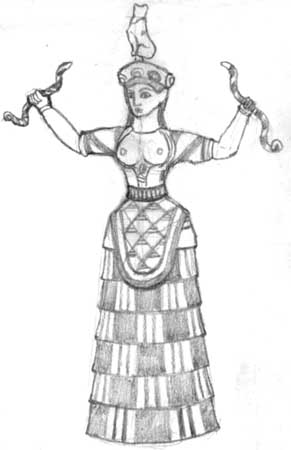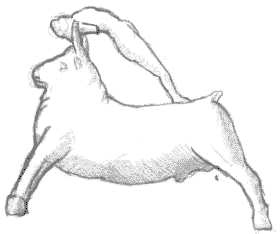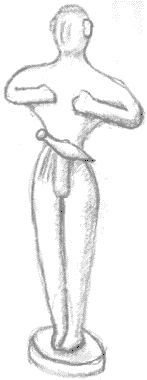| CRETE |
Smaller figurines were almost made from clay, while in the Late Minoan period the faience, ivory or bronze statuettes begun to be produced. One earlier example of teracotta is male warrior of 17 cm high from Petsofa, in eastern Crete(Athens:fig.1). He stands naked except for a loin cloth, a belt and a dagger. His posture to spread out his elbows and to put his hands on the breast is explained as a gesture of prayer. The feature is not represented except for the large ears. Most characteristic statuettes of Late Minoan period are the figurines of a goddess holding snakes in her hands (Herakleion:Fig.2). These were usually made from faience, but a few example were made from ivory and sometimes applied with ornament of gold. They have similarity in their appearance, a tall hat or crown on her head, lowered her arms and the snakes in her hands sometimes coiled round her wrists. Her dress is constricted at her waist often tied with a snake as a belt, and the skirt spreads. Her breasts are exposed from the low-cut dress, which was painted over with brown, blue and green touch. Some relief were also made from faience, representing animals, probably served as ornament for some architectures.  Fig.2 Snake Goddess A few bronze statuettes were left. The manufacture was started in early 16th century B.C. and continued until the end of 12th. These are not hollow, but solid. The process of the casting is as follow: A model was made from wax, and surrounded by clay, then it was fired. Molten metal was poured into the space where the wax melted out. So it is difficult to produce a larger statuette. Fig.3 is one example representing a scene of ceremonial bull-sports, popular subject also in ivory statuettes or mural painting. The acrobat is alighting on the back of a charging bull after turning a somersault over the horns. Statuettes of worshipper were also made.  Fig.3 Bull with acrobat Other than these figurines, stone vessels with reliefed figures were made. Procession of revellers celebrating a seed-time festival is represented on so-called "Hervester Vase". In the developed composition the figures sometimes overlapped. "The Chieftain Cup" is a rare example with a military scene in Cretan art. Bibliography R.Higgins "Minoan and Mycenaean Art" (1977) |
||
| L.D.Caskey "A Chryselephantine Statuette of the Cretan Snake-Goddess"
AJA19 (1915) pp.237 - 249 A.Evans, "Ona Minoan Bronze Group of a Galloping Bull and Acrobatic Figure from Crete" JHS41 (1921) pp.247 - 259 Friedrich Matz, "The art of Crete and early Greece: The prelude to Greek art" (1965) R.Higgins, "Minoan and Mycenaean Art" (1997) |
||
